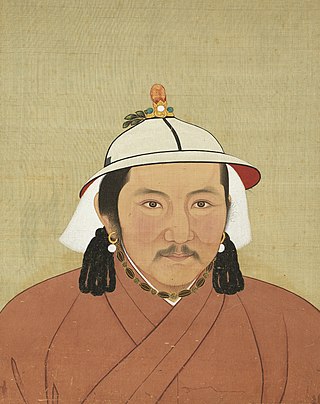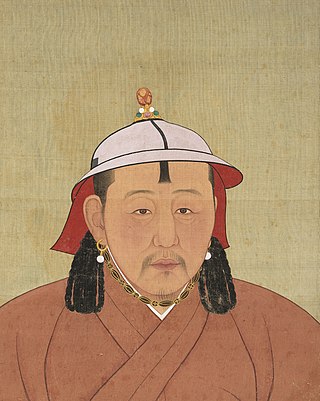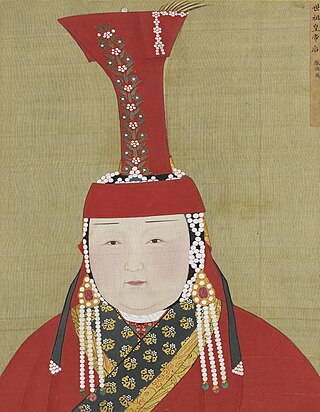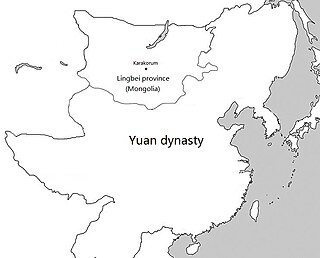This article needs additional citations for verification .(December 2021) |
The following is a list of Mongol consorts. This is list of the consorts of Mongol khagans.
This article needs additional citations for verification .(December 2021) |
The following is a list of Mongol consorts. This is list of the consorts of Mongol khagans.

Budashiri or Buddhashiri was Empress of China and Khatun of Mongols as the wife of Jayaatu Khan Tugh Temür. She acted as an interime regent and was the prominent figure of the Yuan dynasty between 1332 and 1339; she was interim regent after the death of her husband and the election of his successor in 1332-1333, and then regent during the minority of his successor in 1333-1339.
Toghon Temür, also known by his temple name as the Emperor Huizong of Yuan bestowed by the Northern Yuan dynasty and by his posthumous name as the Emperor Shun of Yuan bestowed by the Ming dynasty, was the last emperor of the Yuan dynasty and later the first emperor of the Northern Yuan dynasty. Apart from Emperor of China, he is also considered the last Khagan of the Mongol Empire. He was a son of Kusala.
Khutughtu Khan, born Kuśala, also known by his temple name as the Emperor Mingzong of Yuan, was a son of Khayishan who seized the throne of the Yuan dynasty of China in 1329, but died soon after. Apart from the Emperor of China, he is considered as the 13th Great Khan of the Mongol Empire, although it was only nominal due to the division of the empire.

Jayaatu Khan, born Tugh Temür, also known by his temple name as the Emperor Wenzong of Yuan, was an emperor of the Yuan dynasty of China. Apart from Emperor of China, he is regarded as the 12th Khagan of the Mongol Empire, although it was only nominal due to the division of the empire.
Yesün Temür was a great-grandson of Kublai Khan and an emperor of the Yuan dynasty of China from 1323 to 1328. Apart from Emperor of China, he is regarded as the 10th Khagan of the Mongol Empire, although it was only nominal due to the division of the empire. In Chinese historiography, Yesün Temür, who was very fond of the traditional ways of the Mongols, is commonly known as the Taiding Emperor of Yuan based on his first era name. His name means "nine iron" in the Mongolian language.

Külüg Khan, born Khayishan, also known by his temple name as the Emperor Wuzong of Yuan, was an emperor of the Yuan dynasty of China. Apart from Emperor of China, he is regarded as the seventh Great Khan of the Mongol Empire, although it was only nominal due to the division of the empire. His regnal name "Külüg Khan" means "warrior Khan" or "fine horse Khan" in the Mongolian language.

Öljeyitü Khan, born Temür, also known by his temple name as the Emperor Chengzong of Yuan, was the second emperor of the Yuan dynasty of China, ruling from May 10, 1294 to February 10, 1307. Apart from Emperor of China, he is considered as the sixth Great Khan of the Mongol Empire, although it was only nominal due to the division of the empire. He was an able ruler of the Yuan dynasty, and his reign established the patterns of power for the next few decades.

Kaidu was a grandson of the Mongol khagan Ögedei (1185–1241) and thus leader of the House of Ögedei and the de facto khan of the Chagatai Khanate, a division of the Mongol Empire. He ruled parts of modern-day Xinjiang and Central Asia during the 13th century, and actively opposed his uncle, Kublai, who established the Yuan dynasty. Medieval chroniclers often mistranslated Kadan as Kaidu, mistakenly placing Kaidu at the Battle of Legnica. Kadan was the brother of Güyük, and Kaidu's uncle.
A khatun – a title of Iranian Sogdian origin – is the female counterpart to a khan or a kagan of the Turkic Khaganates and in the subsequent Mongol Empire.
King Chungseon of Goryeo, born Wang Won, later changed his name to Wang Jang, also known by his Mongolian name Ijir Bukhqa (益知禮普花), was the 26th ruler of the Goryeo dynasty of Korea. He reigned in 1298, and again from 1308 to 1313.
Bayan of the Merkid, or Bayan, was a Mongol general of the Merkid clan and an official in the Yuan dynasty.
Orghana was an Oirat princess of the Mongol Empire and Empress of the Chagatai Khanate. She was a daughter of Torolchi, chief of the Oirats and Checheyikhen, daughter of Genghis Khan. She served as regent in the name of her infant son from 1252 to 1261.

Chabi was a Khongirad empress consort of the Mongol-led Yuan dynasty of China, married to Kublai Khan.
Timur, Temur, Temür, Temir, Teymur or Tömör is a masculine Turkic and Mongolic given name which literally means iron. It is a cognate of the Bosnian and Turkish name Demir. In Indonesian, timur translates to east, and symbolizes hope by the rising sun.

The Yuan dynasty ruled over the Mongolian Plateau, including both Inner and Outer Mongolia as well as part of southern Siberia, between 1271 and 1368. The Mongolian Plateau is where the ruling Mongol Borjigin clan of the Yuan dynasty came from, thus it enjoyed a somewhat special status during the Yuan dynasty, although the capital of the dynasty had been moved from Karakorum to Khanbaliq since the beginning of Kublai Khan's reign, and Mongolia had been converted into a regular province, known as the Lingbei Province, by the early 14th century.

Shirindari was Khatun of Mongols from 1294 to 1305 as principal consort of Temür Khan.